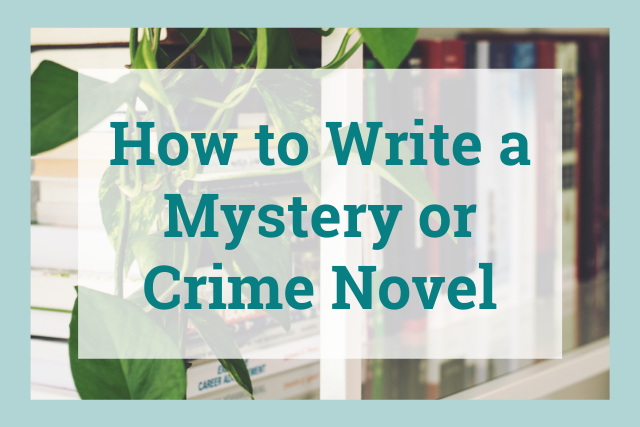
Crime fiction is a leading genre, and readers love the intrigue and suspense of a good mystery.
But writing crime fiction can be daunting. You must leave clues, create captivating characters, build tension, and have a believable villain and crime.
Today, we're giving you our top eight tips on how to write a crime novel.
What Is Crime Writing?
Crime writing is a genre of fiction in which the main plot conflict revolves around a crime.
Crime fiction encompasses many subgenres, including police procedurals, psychological thrillers, and cozy mysteries.
The difference between subgenres depends on the level of violence described, setting, and types of characters, but they all have crime as the driving force.
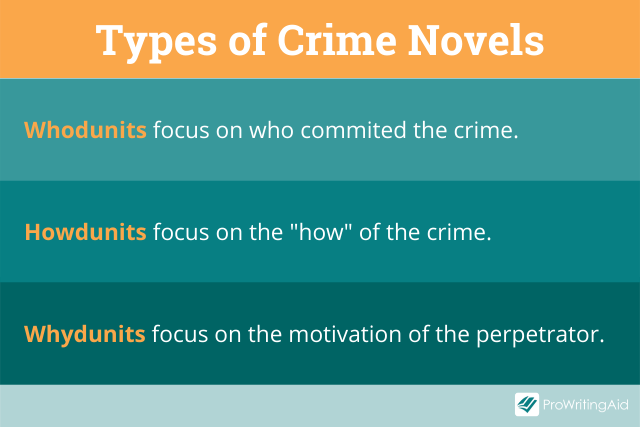
There are three types of mysteries within the crime genre:
- Whodunits are traditional mysteries in which the perpetrator is hidden until the end. Think Sir Arthur Conan Doyle and Agatha Christie.
- Howdunits focus on the "how" of the crime. These are police procedurals and detective stories where the protagonist tracks down the perpetrator. Famous writers in this subgenre are Joseph Wambaugh and Michael Connelly.
- Whydunits focus on the motivation of the perpetrator. This genre shifts the focus from law enforcement to the criminal, who functions as the protagonist. Examples are Mario Puzo’s The Godfather and many of Elmore Leonard’s criminal novel depictions.
What Is Mystery Writing?
The mystery genre is, for all intents and purposes, synonymous with crime fiction. Mystery is a major component of any crime story.
It is possible to have a mystery novel that does not involve a crime, such as uncovering a secret identity, but these are very rare.
Other genres may include a mystery as a secondary plot, but that doesn't make them part of the crime genre. The mystery must be the main plotline in order to be classified as a mystery or crime novel.
8 Tips for Writing Mystery or Crime Fiction
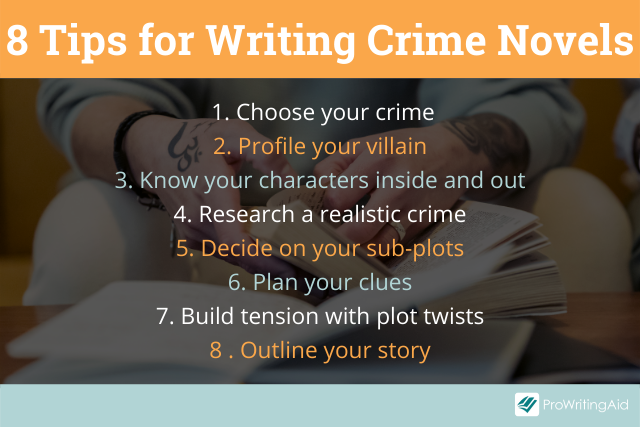
There are many elements to consider when writing crime fiction, so we've broken down the most important steps into eight easy tips.
1. Choose Your Crime
Crime novels feature a variety of crimes, which keeps the genre fresh and exciting.
You could go with a classic murder mystery or serial-killer story. There are heists, organized crime, kidnappings, blackmail, extortion, trafficking, and more.
First, choose your crime. As this is the primary source of conflict in your book, it's important to have the crime first and foremost in your planning.
Once you decide what type of crime your novel is about, plan more of the details. Where did the crime take place? Who was the victim?
You should consider whether it's a locked-room mystery, where the crime seemed impossible to commit, or whether there are multiple leads for your protagonist to follow.
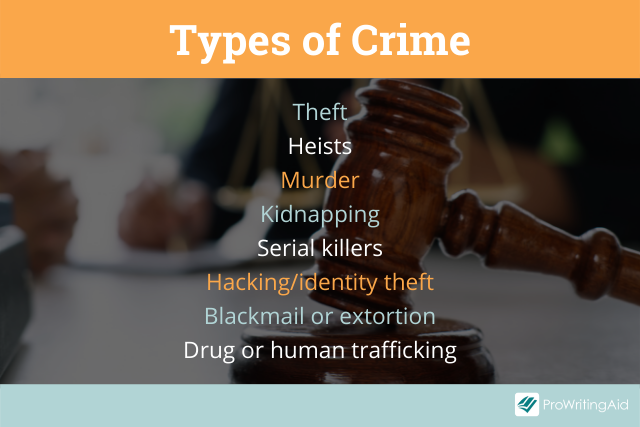
2. Profile Your Villain
Police and other agencies often have criminal profilers. They create a profile for likely demographics, upbringings, and motivations. For your novel, you must become the profiler.
It's important to plan your villain(s) in a crime novel well. The mystery is only as interesting as the character committing the crime. But you must do so in a way that makes sense.
If your villain is pure evil, it can be hard to "humanize" them and make them feel real. If you go down the route of the twisted psychopath, they must have intriguing features to draw readers in.
Maybe there's an extra disturbing element to the crime scene, or maybe they play mind games with the detective.
But most criminals aren't evil, they are human. In fiction, this makes them just as interesting because readers like to see relatable elements, even in a villain.
Start with your villain's motives, then work backward. Ask yourself, why did they commit this particular crime? Give them a solid backstory and plenty of character flaws and character strengths.
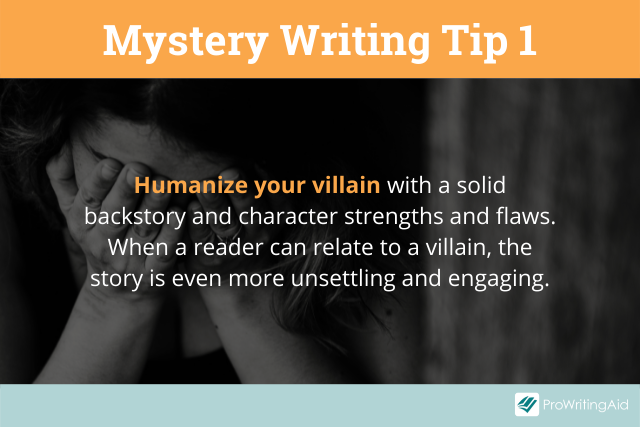
3. Know Your Characters Inside and Out
Crime stories must have interesting characters besides the villain, too. In a mystery, the protagonist is the main character in the investigation.
They might be in law enforcement, a private investigator, or even an amateur detective.
The protagonist must have a strong motivation for wanting to solve the case. They will also need some internal conflict that holds them back or causes them to slip up during the story. Overcoming this internal conflict is important for a good character arc.
There should also be a cast of compelling characters who support the protagonist. Understanding how each of them connects to the mystery will help guide you as you plan conflicts and subplots.
Some subgenres have expected character archetypes. For example, cozy mysteries feature amateur sleuths and quirky side characters.
Most hard-boiled mysteries with a law enforcement protagonist feature a demanding superior officer and a nerdy scientist.
4. Research for a Realistic Crime
The details of criminal activity fascinate readers who love crime novels. They expect a crime novel to feel realistic. Researching the type of crime in the story is especially important for mystery writers.
The internet is a great starting point, but there are many other ways to find answers to those hard-to-search questions. Here are some other places you can find research material:
- Detective memoirs
- Specialty social media groups or accounts, like "Trauma Fiction" on Facebook
- News stories of similar crimes
- Interviews with experts
- True-crime documentaries
You can also find a research librarian at your local library to help you find great sources.
The more details you know about the crime in your novel, the more realistic your writing will be, even if they don't all make it into the final draft.
5. Decide on Your Sub-Plots
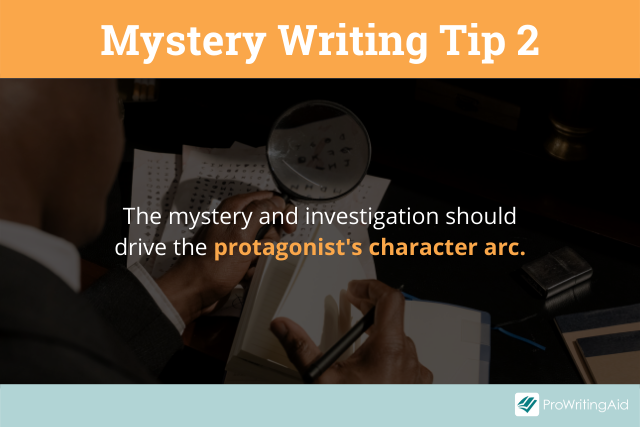
Mysteries are exciting, but they are just one external conflict in a story. A crime novel should have subplots that help drive the story along.
Romance is a common subplot in crime fiction. Family issues, career turning points, or a nemesis colleague can also form smaller conflicts and subplots.
Get creative and find subplots that match your genre but also feel fresh and exciting.
You'll also need a strong internal conflict, as we mentioned previously. Your protagonist needs to undergo character growth in the story so readers feel connected.
Your external conflicts do not necessarily need to be tied to the crime, but the mystery should drive your protagonist's character arc.
The case should teach them something or force them to overcome something.
6. Plan Your Clues
No mystery is complete without really great clues. But throwing in random clues as you write can feel inauthentic and trite.
It's a good idea to spend some time planning your clues before you start writing—even if you aren't much of a plotter.
Once you have researched the crime and know everything about how it happens in your book, you will have plenty of fodder for clues.
Start at the beginning. What clues will be immediately revealed to the detective or sleuth?
These are clues that are present at the scene of the crime, like suspects, blood splatter, broken locks, and dropped belongings.
Then plan the clues your protagonist will discover as the story goes on. They might come from forensic analysis or lab information.
Clues will also appear as your protagonist interviews witnesses and suspects, or as they dig into the victim's back story.
You should also plan a final clue that makes everything "click" for the protagonist. This is the last piece of the puzzle to discover the who/why/how of the crime.
7. Build Tension with Plot Twists
One of the best parts of crime fiction is the plot twist. Plot twists keep readers guessing. It can feel disappointing if the story unfolds in a way that is too easy to figure out.
Plot twists also build tension. Sometimes this tension will come in the form of your protagonist being certain of a lead, only to have it result in a dead end.
Other times, the usual suspects are ruled out, only to be brought back in as suspects at the end.
Red herrings are a common but exciting way to add tension to a mystery.
A red herring is a clue that is placed in a story to mislead or distract the readers. Adding multiple red herrings will make readers even more surprised when the truth comes out.
Avoid the deus ex machina, however.
This is an easy solution to the crime that appears out of nowhere. It does the opposite of building tension and feels clichéd.

8. Outline Your Story
It's a good idea to have a basic outline before you start writing because there are so many important details in a crime novel.
One outline method you can use is to modify the Hero's Journey. Here are what the stages of your story would look like:
- Establish the detective and crime.
- Set up the story.
- Show reluctance of the protagonist.
- First attempt to solve the case.
- Establish facts and create urgency.
- Broaden the scope of the crime and investigation.
- Deepen the detective’s backstory.
- Establish the big change where the detective realizes they're on the wrong track.
- Reveal the criminal’s motive.
- Find the mistake or missing piece of the investigation.
- Solve the crime.
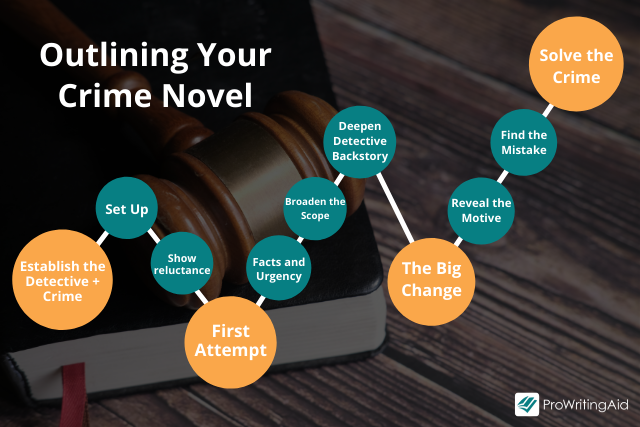
You can also use other plotting methods like a Save the Cat! beat sheet, a Story Circle, or the snowflake method.
Be sure to include the clues that you planned in your outline. This will help them feel logical to the story and serve the overall mystery.
Writing crime fiction doesn't have to be overwhelming. With solid research and deliberate planning, you can write the next great mystery novel.
Writing crime? Join us for Crime Writers' Week: June 20 - 23, 2022
Unlock the secrets for writing, editing, and publishing a crime story at this weeklong free online summit. Connect with thousands of other crime writers while learning how to develop, write, edit, and publish a show-stopping crime novel.
Sign up for free now


